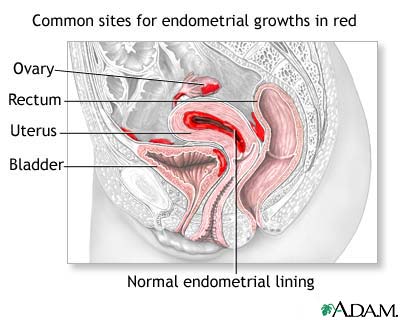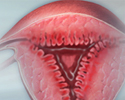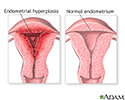Endometriosis
Pelvic pain - endometriosis; Endometrioma
Endometriosis occurs when cells from the lining of your womb (uterus) grow in other areas of your body. This can cause pain, heavy bleeding, bleeding between periods, and problems getting pregnant (infertility).
Causes
Every month, a woman's ovaries produce hormones that tell the cells lining the uterus to swell and get thicker. Your uterus sheds these cells along with blood and tissue through your vagina when you have your period.
Endometriosis occurs when these cells grow outside the uterus in other parts of your body. This tissue may attach on your:
- Ovaries
- Bowel
- Rectum
- Bladder
- Lining of your pelvic area
It can grow in other areas of the body, too.
These growths stay in your body, they do not shed when you have your period. But, like the cells in your uterus, these growths react to the hormones from your ovaries. They grow and bleed when you get your period. Over time, the growths may add more tissue and blood. The buildup of blood and tissue in your body leads to pain and other symptoms.
No one knows what causes endometriosis. One idea is that when you get your period, the cells may travel backwards through the fallopian tubes into the pelvis. Once there, the cells attach and grow. However, this backward period flow occurs in many women. Researchers think that the immune system in women with endometriosis may cause the condition.
Endometriosis is common. Sometimes, it may run in families. Endometriosis probably starts when a woman begins having periods. However, it usually is not diagnosed until ages 25 to 35.
You are more likely to develop endometriosis if you:
- Have a mother or sister with endometriosis
- Started your period at a young age
- Never had children
- Have frequent periods, or they last 7 or more days
- Have a closed hymen, which blocks the flow of menstrual blood during the period
Symptoms
Pain is the main symptom of endometriosis. You may have:
- Painful periods.
- Pain in your lower belly before and during your period.
- Cramps for a week or 2 before and during your period. Cramps may be steady and range from dull to severe.
- Pain during or following sexual intercourse.
- Pain with bowel movements.
- Pelvic or low back pain that may occur at any time.
You may not have any symptoms. Some women with a lot of tissue in their pelvis have no pain at all, while some women with milder disease have severe pain.
Exams and Tests
Your health care provider will perform a physical exam, including a pelvic exam. You may have one of these tests to help diagnose the disease:
-
Transvaginal ultrasound
Transvaginal ultrasound
Transvaginal ultrasound is a test used to look at a woman's uterus, ovaries, tubes, cervix and pelvic area. Transvaginal means across or through the ...
 ImageRead Article Now Book Mark Article
ImageRead Article Now Book Mark Article -
Pelvic
laparoscopy
Laparoscopy
Diagnostic laparoscopy is a procedure that allows a doctor to look directly at the contents of the abdomen or pelvis.
 ImageRead Article Now Book Mark Article
ImageRead Article Now Book Mark Article
Treatment
Learning how to manage your symptoms can make it easier to live with endometriosis.
Learning how to manage your symptoms
Pelvic pain - living with endometriosis; Endometrial implant - living with endometriosis; Endometrioma - living with endometriosis
What type of treatment you have depends on:
- Your age
- Severity of your symptoms
- Severity of the disease
- Whether you want children in the future
There are different treatment options.
PAIN RELIEVERS
If you have mild symptoms, you may be able to manage cramping and pain with:
- Exercise and relaxation techniques.
-
Over-the-counter pain relievers
. These include ibuprofen (Advil), naproxen (Aleve), and acetaminophen (Tylenol).
Over-the-counter pain relievers
Over-the-counter (OTC) pain relievers can help relieve pain or lower a fever. Over-the-counter means you can buy these medicines without a prescript...
 ImageRead Article Now Book Mark Article
ImageRead Article Now Book Mark Article - Prescription painkillers, if needed, for more severe pain.
- Regular exams every 6 to 12 months so your doctor can make sure the disease is not getting worse.
HORMONE THERAPY
These medicines can stop endometriosis from getting worse. They may be given as pills, nasal spray, or shots. Only women who are not trying get pregnant should have this therapy. Hormone therapy will prevent you from getting pregnant. Once you stop therapy, you can get pregnant again.
Birth control pills. With this therapy, you take pills for 6 to 9 months without stopping. Taking these pills relieves most symptoms. However, it does not prevent scarring or treat any damage that has already occurred.
Progesterone pills or injections. This treatment helps shrink growths. However, side effects can include weight gain and depression.
Gonadotropin-agonist medicines. These medicines stop your ovaries from producing the hormone estrogen. This causes a menopause-like state. Side effects include hot flashes, vaginal dryness, and mood changes. Treatment is usually limited to 6 months because it can weaken your bones.
SURGERY
Your provider may recommend surgery if you have severe pain that does not get better with other treatments.
-
Laparoscopy
helps diagnose the disease and can also remove growths and scar tissue. Because only a small cut is made in your belly, you will heal faster than other types of surgery.
Laparoscopy
Pelvic laparoscopy is surgery to examine pelvic organs. It uses a viewing tool called a laparoscope. The surgery is also used to treat certain dise...
 ImageRead Article Now Book Mark Article
ImageRead Article Now Book Mark Article -
Laparotomy
involves making a large incision (cut) in your belly to remove growths and scar tissue. This is major surgery, so healing takes longer.
Laparotomy
Abdominal exploration is surgery to look at the organs and structures in your belly area (abdomen). This includes your:AppendixBladderGallbladderIn...
 ImageRead Article Now Book Mark Article
ImageRead Article Now Book Mark Article - Laparoscopy or laparotomy may be a good option if you want to become pregnant, because they treat the disease and leave your organs in place.
-
Hysterectomy
is surgery to remove your uterus, fallopian tubes, and ovaries. If your ovaries are not removed, symptoms may return. You would only have this surgery if you have severe symptoms and do not want to have children in the future.
Hysterectomy
Hysterectomy is surgery to remove a woman's womb (uterus). The uterus is a hollow muscular organ that nourishes the developing baby during pregnancy...
 ImageRead Article Now Book Mark Article
ImageRead Article Now Book Mark Article
Outlook (Prognosis)
Hormone therapy and laparoscopy cannot cure endometriosis. However, in some women, these treatments may help relieve symptoms for years.
Removal of the uterus, fallopian tubes, and both ovaries (a hysterectomy) gives you the best chance for a cure.
Possible Complications
Endometriosis can lead to problems getting pregnant. However, most women with mild symptoms can still get pregnant. Laparoscopy to remove growths and scar tissue may help improve your chances of becoming pregnant. If it does not, you may want to consider fertility treatments.
Other complications of endometriosis include:
- Long-term pelvic pain that interferes with social and work activities
- Large cysts in the pelvis that may break open (rupture)
In rare cases, endometriosis tissue may block the intestines or urinary tract.
Very rarely, cancer may develop in the areas of tissue growth after menopause.
When to Contact a Medical Professional
Call your provider if:
- You have symptoms of endometriosis
- Back pain or other symptoms reoccurring after endometriosis is treated
You may want to get screened for endometriosis if:
- Your mother or sister has the disease
- You are unable to become pregnant after trying for 1 year
Prevention
Birth control pills may help to prevent or slow down the development of the endometriosis.
References
ACOG Practice Bulletin No. 110: noncontraceptive uses of hormonal contraceptives. Obstet Gynecol . 2010;115(1):206-218. PMID: 20027071 www.ncbi.nlm.nih.gov/pubmed/20027071 .
Brown J, Pan A, Hart RJ. Gonadotrophin-releasing hormone analogues for pain associated with endometriosis. Cochrane Database Syst Rev . 2010;(12):CD008475. PMID: 21154398 www.ncbi.nlm.nih.gov/pubmed/21154398 .
Burney RO, Giudice LC. Endometriosis. In: Jameson JL, De Groot LJ, de Krester DM, et al, eds. Endocrinology: Adult and Pediatric . 7th ed. Philadelphia, PA: Elsevier Saunders; 2016:chap 130.
de Ziegler D, Borghese B, Chapron C. Endometriosis and infertility: pathophysiology and management. Lancet . 2010;376(9742):730-738. PMID: 20801404 www.ncbi.nlm.nih.gov/pubmed/20801404 .
Giudice LC. Clinical practice. Endometriosis. N Engl J Med . 2010;362(25):2389-2398. PMID: 20573927 www.ncbi.nlm.nih.gov/pubmed/20573927 .
Lobo R. Endometriosis: etiology, pathology, diagnosis, management. In: Lentz GM, Lobo RA, Gershenson DM, Katz VL, eds. Comprehensive Gynecology . 6th ed. Philadelphia, PA: Elsevier Mosby; 2012:chap 19.
-
Endometriosis
Animation
-
Pelvic laparoscopy - illustration
Laparoscopy is performed when less-invasive surgery is desired. It is also called Band-Aid surgery because only small incisions need to be made to accommodate the small surgical instruments that are used to view the abdominal contents and perform the surgery.
Pelvic laparoscopy
illustration
-
Endometriosis - illustration
Endometriosis is the condition in which the tissue that normally lines the uterus (endometrium) grows on other areas of the body causing pain and irregular bleeding.
Endometriosis
illustration
-
Abnormal menstrual periods - illustration
Abnormal menstrual periods may have a variety of causes, such as endometrial hyperplasia, endometrial polyps, uterine fibroids, and abnormal thyroid or pituitary function.The endometrium is the tissue lining the uterus. When the endometrium becomes unusually thick it is called endometrial hyperplasia. Hyperplasia may cause profuse or extended menstrual bleeding.
Abnormal menstrual periods
illustration
-
Pelvic laparoscopy - illustration
Laparoscopy is performed when less-invasive surgery is desired. It is also called Band-Aid surgery because only small incisions need to be made to accommodate the small surgical instruments that are used to view the abdominal contents and perform the surgery.
Pelvic laparoscopy
illustration
-
Endometriosis - illustration
Endometriosis is the condition in which the tissue that normally lines the uterus (endometrium) grows on other areas of the body causing pain and irregular bleeding.
Endometriosis
illustration
-
Abnormal menstrual periods - illustration
Abnormal menstrual periods may have a variety of causes, such as endometrial hyperplasia, endometrial polyps, uterine fibroids, and abnormal thyroid or pituitary function.The endometrium is the tissue lining the uterus. When the endometrium becomes unusually thick it is called endometrial hyperplasia. Hyperplasia may cause profuse or extended menstrual bleeding.
Abnormal menstrual periods
illustration
Review Date: 9/26/2015
Reviewed By: Daniel N. Sacks MD, FACOG, obstetrics & gynecology in private practice, West Palm Beach, FL. Review Provided by VeriMed Healthcare Network. Internal review and update on 09/01/2016 by David Zieve, MD, MHA, Isla Ogilvie, PhD, and the A.D.A.M. Editorial team.






